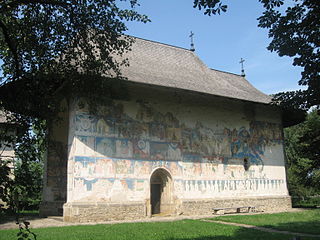
The Bucovina (Romanian Bucovina, Ukrainian Буковина / Bukowyna) is a region in the north Romania. This is the southern part of the historical region of Bukovina, the northern part of which is now in the Ukraine lies. Bucovina borders in the east Moldova, in the south to the Moldova region and Transylvania and in the west to the region Maramureş.
places
&groups=Maske,Track,Aktivitaet,Anderes,Anreise,Ausgehen,Aussicht,Besiedelt,Fehler,Gebiet,Kaufen,Kueche,Sehenswert,Unterkunft,aquamarinblau,cosmos,gold,hellgruen,orange,pflaumenblau,rot,silber,violett)
Other goals

- Moldavian monasteries (Bisericile pictate din nordul Moldovei). The main attraction of the region are the Moldavian monasteries, of which the most beautiful are part of the world cultural heritage and which are famous for their splendid exterior paintings. The monasteries are part of the world heritage.

- 6 Putna Monastery (Mănăstirea Putna). was made by Stephen the Great originally laid out as a grave site.
- 1 Moldoviţa forest railway (gara Moldovița). The Moldoviţa forest railway was opened in 1888 with a length of 24 km between Moldoviţa and Roşoşa and reached a total length of 73 km by 1987. . The forest railway was discontinued in 2003. In 2005, a 3.5 km long section was repaired on a private initiative and used sporadically. From 2009, regular tourism operations began and the route was gradually extended.
background
Bukovina was once part of the historical Principality of Moldova. At the beginning of the 16th century, the principality became a vassal state of the Ottoman Empire.
In 1775 the Ottoman Empire ceded Bukovina to Austria. Subsequently, Germans from southwest Germany, Bohemia and Austria were settled, who were later referred to as Buchenland or Bukowina Germans. As a result, Bukovina was strongly multiethnic and multicultural. In the 1910 census, 41% were “Ruthenians” (i.e. Ukrainians), 31% Romanians, and 22% German-speaking (although Yiddish was also counted as German). 13% of the population were of Jewish faith. In 1918 Bukovina became part of the young state of Romania.
During the Second World War, the Soviet Union occupied the northern part of Bukovina, which was predominantly populated by Ukrainians. Subsequently, nearly 100,000 Bukowina Germans were resettled in the German Empire. The remainder moved to the Federal Republic after the war, so that there has been practically no German minority since then. The Jewish population was destroyed in the Holocaust or emigrated to Palestine and America. After the Second World War, the region was then divided into a northern part, which went to Ukraine (or Soviet Union), and a southern part, which remained with Romania.

_from_Fortess.jpg/320px-View_on_Suceava_(Romania)_from_Fortess.jpg)










